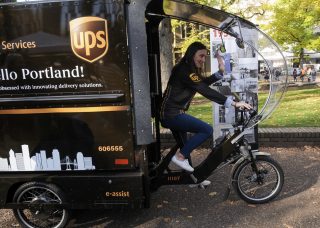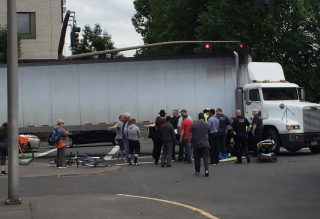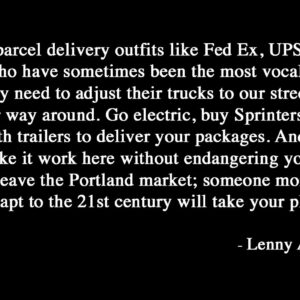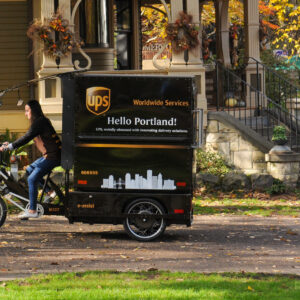
(Photo: J. Maus/BikePortland)
The Portland Bureau of Transportation has launched an update to the Freight Master Plan and the first place they stopped to ask for feedback was the bicycle advisory committee.
That makes sense given the tragic legacy of death and injury left behind by drivers of big trucks on Portland’s central city streets.
For years we’ve failed to mitigate the immense risks posed by trucks. With a massive boom in e-commerce and new ideas around how we use streets and curb space, the freight plan just might be a perfect opportunity to finally make progress.
PBOT planner Stephanie Lonsdale and freight coordinator Bob Hillier laid out the context of the issue at the meeting last night.
Advertisement
Lonsdale equated our current handling of deliveries to, “A transit system where you didn’t plan for the bus stops.” She described a “paradoxical tension between freight and livability”. “The factors that make a community livable — like more bicycle and pedestrian infrastructure, increased density and mixed uses — increase freight demand while reducing freight access,” she said.
In 2019 PBOT commissioned a study (PDF) into how e-commerce and technology were impacting urban deliveries. The findings were striking:
— Between 2010 and 2017, U.S. e-commerce retail sales grew from $165 billion to $453 billion, a 175% increase.
— Between 2009 and 2017, the average number of monthly online deliveries per household more than doubled from 2.4 to 4.9.
— Between 2015 and 2017, Oregon on-line sales jumped by 50%.
— Over the past year alone PDX air cargo plane traffic grew by 12 commercial flights per day attributed to growth in e-commerce.
— Between 2000 and 2018, despite a 37% decrease long-haul truck mileage overall, vehicle miles traveled by commercial trucks increased 18% between 2011 and 2016, primarily due to significant growth in short-haul and last-mile truck trips.
Portland Freight Coordinator Bob Hillier said PBOT is looking into a host of strategies to improve urban delivery including different forms of pricing (more on that below), increased use of parcel lockers, off-peak hour delivery times, curb management technology like CurbFlow (a company that has already pitched its tool to PBOT), and incentives for emissions-free vehicle use.

If you’re waiting for Portland to regulate away big and dangerous trucks in favor of electric cargo trikes or smaller vehicles, you’ll have to keep on waiting. Hillier threw cold water on that idea when it came up discussions from committee members last night. He said it comes down to economics for the delivery company and he maintained that larger trucks are ultimately safer and more efficient.
“With larger trucks the driver is a professional and must have a CDL [commercial driver’s license], with smaller trucks they don’t,” Hiller said. “So you’ve got professional drivers on the road that understand the safety and they’re not out to run anybody over.” As for for using smaller vehicles, Hiller said since larger trucks can carry more (he cited 15,000-pound capacity of a FedEx van versus 800-pound capacity of a B-Line cargo trike), a large truck has “collectively less impact than multiple smaller trucks in terms of fuel use and wear-and-tear on the roadway.” Economically-speaking, Hiller pointed out that it’s simply cheaper for companies to pay one driver to haul 15,000 pounds than to pay that same driver to haul 800 pounds.
Advertisement
Committee member (and mayoral candidate) Sarah Iannarone spoke up to say the entire framing of the conversation was wrong.
“Why are we acting like consumer demand is going to drive all our decision-making when it comes to infrastructure? We should be using climate action, human rights, and equity and the front of our policy agenda,” she said. “My concern is about people living here and keeping them safe.”

(Photo: @SmplicityCycles via Twitter)
Iannarone added that in her view e-commerce and its free-and-fast delivery model people love is only possible because, “We’ve allowed [these companies] to use our infrastructure for free.”
With the huge spike in deliveries not just from usual suspects like UPS, Amazon and FedEx but the myriad smaller and local companies who’ve jumped on the direct-to-consumer trend, several committee members seemed to support a tax on delivery drivers and/or some sort of fee for companies that profit off the right-of-way. Committee member Clint Culpepper wondered if the city would explore something similar to the 50-cent surcharge PBOT collects each time someone pays for an Uber or Lyft ride.
Jamey Duhamel a policy advisor for Commissioner Chloe Eudaly who’s become a regular at bike advisory committee meetings, said her boss is already headed in that direction with the formation of the Pricing Options for Equitable Mobility Task Force. “Right now they are taking up the question of how we price the right-of-way, including parking fees, congestion pricing, even how to price right-of-way for these delivery platforms.”
There’s so much at stake with our urban delivery policy. We’ll be watching this plan update closely. Learn more about the 2040 Freight Plan at Portland.gov.
— Jonathan Maus: (503) 706-8804, @jonathan_maus on Twitter and jonathan@bikeportland.org
— Get our headlines delivered to your inbox.
— Support this independent community media outlet with a one-time contribution or monthly subscription.






Thanks for reading.
BikePortland has served this community with independent community journalism since 2005. We rely on subscriptions from readers like you to survive. Your financial support is vital in keeping this valuable resource alive and well.
Please subscribe today to strengthen and expand our work.
One issue to think about is the make up of the Bike Advisory Committee vs the Freight Advisory Committee. When I was the chair of the PBAC all the members were volunteers and we met at night. During the same time period the FAC was filled with members who were there as part of their day jobs, and they met during the day (and had much better snacks!). It is great to ask the PBAC, and hopefully take their input, but the two committees (at least back then) did not have the same level of access or influence.
Yep. Couldn’t agree more. This came up at last night’s meeting and I left it out of the post because I know we’ll cover it more in the coming weeks and months.
PBOT needs to enforce term limits on the Freight Committee, who say they’re exempt from same rules that forced lots of longtime BAC folks out (including you, right?!). And Iannarone mentioned last night that perhaps we need a bike-specific voice at the freight committee or some sort of the BAC/PFC liaison position.
At the least PBOT needs to acknowledge the relative imbalance in power between these committees and do something to level it out.
Power exists only at the Council. The others are advisory.
We should also own up to being complicit in the freight system demand every time we order something and have it delivered to our homes or buy it at the store. I want the stuff I buy to be available and inexpensive. Sure, there are times when I willingly pay a premium, but not always.
True, but that’s how lobbying works,by influence. If all or the majority of influencing voices express one view, that view becomes policy.
Ordering things online and having them delivered does not mean we need huge semis on our city streets. I’ve spent time in Frankfurt and Barcelona and never saw large trucks in the city. Surely those residents have delivery.
They should just put both the committees together in one room. Start with a monologue of cyclists who lost their lives. Then we would have some collaboration. There are nice truckers in there but they are not advocates for GHG reductions or cyclist. Can we please oust Jana Jarvis from the Chair. Shes in Salem a lot woth more sway on Portland roads then Ted Wheeler;) and she doesnt even live here.
I too listened in during this BAC meeting, thanks to Zoom (even though it was 9pm to 11pm here on the East Coast). 5 yeas ago when I was still a member of the BAC (and the Bureau & Budget Advisory Committee too) I would have taken this announcement seriously. But now I can’t help but laugh. In my local NC community, the City Manager would ask that the city transportation department or the MPO to create a freight master plan with no community input except one ‘open house’, but with same result as in Portland: nothing useful will come of it. PBOT is still using the Freight Advisory Committee, a group of paid and subsidized insiders, but to appease the neighborhoods and nonprofits, they are creating a citizen’s advisory committee, as well as a technical advisory committee for other agencies and elected officials. A plan will be created by paid city staff over a 2-3 year period with various open houses, hearings, protests, etc. And no one will use the plan for anything – industry will bypass it, e-commerce will ignore it, and Bozos will get richer. Same outcome, different pace.
A degree of irony was the ad for no-fee, same-day home delivery of hard cider from Reverend Nat’s at the top and bottom of the article.
Oh man, sometimes I miss irony, sometimes I am the one to see it first, what’s the irony about a local delivery. I would hardly call that freight…
I live on Rosa Parks where there are curb delineated bike lanes without no car parking (it’s on the other side of the street) and have noticed a big uptick in delivery drivers parking in the bike lane. DHL and other experienced delivery folks will park in the centre turn lane, but food delivery, FedEx and UPS all park in the lane “for just a minute.” As curbside bike lanes become more common, I’m curious if drivers will be taught where they are legally allowed to park during delivery if a bike lane is present. (I’m assuming that parking in the centre lane is the right/legal thing to do, but perhaps someone else knows for sure.)
I wonder what the traffic count on Rosa Parks is?
You could tag the relevant Twitter account and post a video of the incident. Sometimes letting the viral community have it’s way is better than a 1:1 conversation with a dispatch manager.
Good idea!
It’s not that they don’t know, they don’t care.
Any “bike lane” that a car can park in is just a shoulder with a sharrow in it.
…”a large truck has “collectively less impact than multiple smaller trucks in terms of fuel use and wear-and-tear on the roadway…”
How does that statement mesh with the Fourth Power Rule for roadbed wear-and-tear?
The Fourth Power Rule: Researchers have found that damage to the roadbed is proportional to the 4th power of the axle load of the vehicle. If you double the weight on an axle, your vehicle does sixteen times the damage to the road. If you make two deliveries with half the total weight, then you do 8 times less damage. Factoring in weight to carry ratios for different sized trucks, it would still be over 6 times worse for the bigger truck. The only way I can get this to go less than 1x is to compare a large truck carrying a small load vs the same large truck carrying one half of the already small load but twice.
http://johnscreekga.granicus.com/MetaViewer.php?view_id=1&clip_id=256&meta_id=32762
https://pavementinteractive.org/reference-desk/design/design-parameters/equivalent-single-axle-load/
This is true from a road damage point of view, but his general point that it’s safer/better to use big trucks when appropriate still holds. Note that weight/axle is a function of what’s actually carried.
It takes a fleet of small delivery vehicles to haul what one big truck can. Aside from the space, you have more operators going in different directions for many more vehicle miles, creating more conflicts, spewing more exhaust, etc.
The safest vehicle is the one that’s not even there. If you have significantly fewer drivers who are better regulated, more professional, and operate more predictably, you come out ahead.
A fleet of small trucks may well put in fewer miles; a series of out and backs may be shorter than making the rounds. If those out-and-backs are using smaller vehicles, it’s going to be a win.
Absolutely, but the incentive to use the smaller vehicles is already there when the bigger ones are more expensive and more difficult to use.
It’s not like you ever see major pizza chains using large trucks to deliver individual pies even though they sell huge numbers of them.
And let’s not overestimate the skill of Class C (average people drivers license) drivers. Most people can get a job driving a big, unwieldy box truck with absolutely ZERO prior experience driving anything bigger than an economy car. A lot of these small truck deliver companies hire based solely upon a review of someone’s driving record which sounds good but doesn’t mean that the new employee has any aptitude for driving a big truck in crowded urban spaces.
That being said: obviously large trucks cannot and should not go everywhere – only where it has proven safe to operate.
When I was attached to a cabinet account out of Grants Pass I made most of my deliveries in the Los Angeles area. Even when I made multiple stops at cabinet stores one stop was always as at a local delivery company (transload facility I think?) that then made multiple deliveries to locations that 75′ of truck and trailer can’t safely get to.
I think my favorite was a delivery to a residential neighborhood in San Francisco near Haight-Ashbury. When I couldn’t find official truck route maps of the area I called the police department. Their instructions were: “don’t hit anything.” I really didn’t like where I had to go and how slow going some turn maneuvers were but I got in and out safe and legal. I know that most of the newer Class A (commercial driving license) drivers would have taken out cars, signs and/or people. It required massive amounts of attention and time. It absolutely should not be an area for large trucks just because no one explicitly banned them yet.
Because it does. One of the reasons we don’t see traction on climate or transportation is because the city is committed to keeping the neoliberal capitalist machine humming and happy—the same system that puts profits over the environment, profits over people, people of color at the bottom, and the perceptions and concerns of white business owners over those of frontline communities and their allies. There doesn’t seem to have been recognition that accommodating business as usual and rooting out inequity/significantly addressing climate change/curbing traffic violence are insoluble. Government everywhere has let e-commerce fill our streets and skies because it doesn’t think it has any business regulating how much stuff people buy. And it doesn’t, directly. But it is responsible for addressing the impacts of Jeff Bezos’ race to the bottom where anyone can have anything they want in two days on the cheap.
It is difficult for PBOT to handle this upstream of Portland’s streets, but taking the explosion of e-commerce as a given that must simply be borne by our streets and the people on and near them (when standing by and letting that explosion happen at the scale it will is deadly in the short and long term) doesn’t seem like the responsible thing to do.
This accommodating stance to consumerist trends seems to come from the belief that a happily running economy will deliver prosperity for all—if some people can have businesses, they can employ people and pay them well so employees can afford food and shelter and recreation and education for the next generation. We’re fresh off one of the longest periods of unremitting economic growth and all that has come to pass is greater concentration of wealth and broadening of disparities. It seems time to stop hoping the Invisible Hand magics us to an equitable ecotopia some day and quit freaking out if we do something that upsets those (old white men) in charge (and most insulated from impacts) who are the primary status quo beneficiaries. Like take a parking spot, or something.
Old and white. The head of the FCC is neither old, or white, but he embodies the very evil that you describe.
Freight? The manner in which so many folks purchase crap WILL continue to fuel the irony here. I have joked and cried for years that people have no respect for movement. Goods and people “moving” about. That toilet paper, flower, and hand sanitizer has to be delivered and a rickshaw won’t meet the current need. Too many people with too many devices.
Bernie Sanders is an old white man.
He sure is, always has been. Did you see the recently released archive of public access T.V. show he did? It’s cringey, to say the least.
In one scene, he rolls up on some young kids, kicks open his car door and starts talking to them. In an age when parents were telling their children not to talk to strangers, the Mayor should abide.
In another scene, he literately asks kids if they know where to get some cocaine.
https://youtu.be/-oxfzabpTWY
“…not out to run anybody over.”
This guy is too much. Google image search “big rig pileup”. They all had the special license.
Blind spot size, sleepiness, and stimulant use are bigger factors than the type of license.
“City seeks token interaction with per-approved cyclist who represent affluent areas of the city that have less damage from heavy freight moving on surface streets.”
FTFY
This is the real deal right here. Freight (as we know it today) is an economy of scale. Why would a profitable company convert from a “sound” model to an untested model? Such as a fleet of tiny cargo bike couriers. Or an intermediary scale, such as the typical parcel deliver van (FedEx, UPS, Amazon). Anyone remember the William’s Bakery – Triple Trailer debacle from back in the 80s?
At some point, policy makers need to take their head out of the sand. Industrial Capitalism has taken us to where we are now. Inundated with community-health impairing infrastructure. Natural Capitalism goes beyond the value of money and incorporates the value of natural resources, including human life, and the effect of pollution on those resources.
As long as policy makers are beholden to the influence of stogy practices, change wont come.
This statement is true *given current policies and regulations*. If those changed, so would be the economic incentive to deliver by alternative modes. Portland would need to change these policies and then the companies would follow. For instance, imposing a street use tax that’s based on weight of a vehicle would shift economic incentives to smaller vehicles or bikes.
It is annoying to see policymakes make these statements as if such economic decisions are made within a policy vacuum. They never are! And it is the responsibility of the policymakes to set policies to get the results they want instead of throwing the hands up in the air, proclaiming that nothing can be done, and then proceed by doing nothing.
On the subject of use tax, the downtown surface roads should be toll restricted to motor vehicles; impose a toll to get off the freeway or cross into downtown. Too many vehicles traverse downtown to get to destinations across the rivers, through the tunnel or down south.
There are plenty of large trucks with 15,000 lbs. of payload capacity, but these are not what we see on our neighborhood streets. I think it’s important to note that the typical vans from Fed Ex, UPS, and others, running through our neighborhoods have payload capacities more like 3000 – 4000 lbs.
Also, we should recognize that very often these are not filled to capacity. Even if they are full at the beginning of their shift, they gradually deliver down to zero – so their average payload is half their capacity … on the best day. When some parcels take priority and have to be delivered ‘same day’, some vans are running near empty because time becomes more important than capacity. This is really inefficient.
eBikes and eTrikes are the right vehicles in certain settings, and I would argue that most downtowns and Main streets fit the bill.